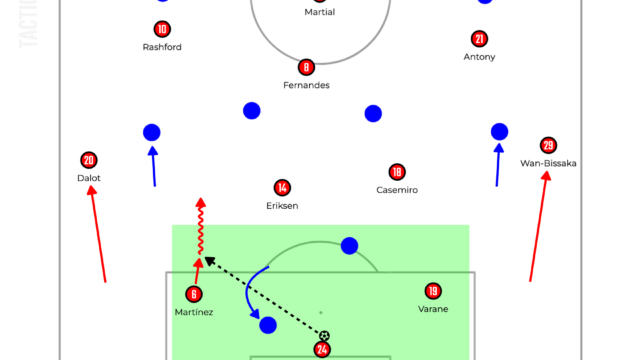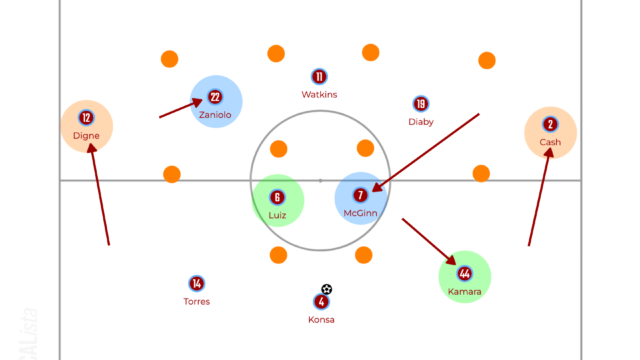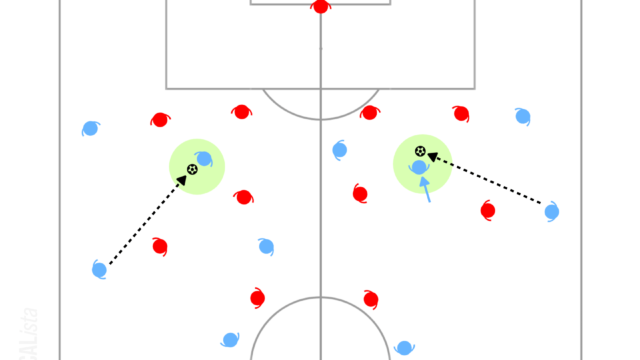Ten Hag’s Ajax Tactical Analysis ~No Pain No Gain~

Introduction
Ajax managed by Erik Ten Hag who will be the next manager of Manchester United is going to be analysed in this article. Especially, I am going to focus on the amazing performance that Ajax scored 98 goals in 34 league games and analyse how they attack in final 3rd of the pitch.
Line up

Build up
Before analysing Ajax’s final 3rd attacking, let’s focus on the system when playing from the back because it is impossible to divide the connection of each phase of the game. Basically, 3 attackers and 2 attacking midfielders (AMF) of 4–1-2-3 position themselves behind the opposition midfield line and 4 defenders, the pivot and the goalkeeper (GK) try to play through the opposition pressing. Instead of AMFs dropping back to receive the ball, full backs (FB) change their positions dynamically to receive the ball behind the opposition pressure. For example, their movements are not only vertically but also horizontally. The FB often moves into inside of the pitch to receive the ball.

After progressing the ball into the opposition half, there are some differences between the right side and left side. In the right-hand side, the winger (WG) Antony keeps width but the left side is more flexible. The WG Tadić sometimes comes inside and the AMF Gravenberch or the FB Blind move to the wide lane.
Ajax try to penetrate into the penalty area (PA) from WGs. Before playing to the WG, the FB moves into the pocket which is the space between the FB and the centre back (CB) and between the MF line and the DF line. Thanks to this movement, it is possible to create 2v1 against the opposition FB. The opposition FB needs to pay attention to the FB who is closer to the goal than the WG, so the WG can gain time and space to receive the ball. This is the reason why Ajax can give favourable opportunity for WGs to start attacking in the final 3rd.

Penetration into the PA
In this chapter, how to play into the PA is going to be analysed. The beginning of the attacking in the final 3rd often created by WGs. Then, 2nd or 3rd players support the WG and destroy the opposition defensive block.
As the 2nd player’s support, the player pinning the opposition FB runs in behind. Additionally, if the WG receives the ball little bit inside or there are no players in the pocket, the 2nd player overlaps the WG instead of underlapping. In both cases, the principle that 2nd player runs in behind the opposition DF line does not change. And this support movement gives the WG 2 options which are dribbling inside and playing to the 2nd player.
On the other hand, if the WG is pressed quickly and does not have enough time to wait for the 2nd player running in behind, the WG plays one-two with the 2nd player in the pocket. However, this is not the main option and basically the 2nd player’s support is running in behind by overlapping or underlapping with the WG.

Then, the 3rd man support when the 2nd player’s support is not used is going to be analysed. There are mainly 2 patterns, which are that the 3rd player uses the space made by running of the 2nd player or the 1st player on the ball uses the space with playing short one-two with the 3rd player.
Firstly, the pattern of the 3rd player running into the space created by the 2nd player is going to be analysed. And the wide variation of the player comes into the space is one of the strengths of Ajax. Mainly, the FB or the AMF would be the 3rd man. One of them usually support the WG as the 2nd player and another player comes into the space as the 3rd player. Additionally, Haller (striker) or Álvarez (pivot) can be the 3rd player. Therefore, Ajax never lacks the 3rd player and creates flexible combination again and again, which will not give the opponent to organise the defensive block.

The next 3rd man support is holding the defender and short one-two with the player on the ball. In this case, it is possible to penetrate into the small gap of the defensive block. If playing through the opposition DF line, it is possible to deliver a cross and if playing into the space between the lines, it is possible to shoot from the middle range.

After entering the PA, the type of delivering crosses depends on the height of the opposition DF line. If the DF line is high and there is a gap between the DF line and the GK, just squaring the ball and tapping it in is the main option. On the other hand, if the opposition defenders drop back to close the space between the DF line and the GK, the ball will be delivered to the area in front of the opposition defenders.

It is difficult for defenders to react the ball sent into the area behind them with running towards the own goal and there will be a huge area around the penalty spot if opposition midfield players delay dropping back. The decision of the type of delivery is simple and clear.
Crosses from Outside of the Box
Although Ajax can penetrate into the PA in many cases, it is difficult to do it when the opposition team set 10-man block in front of the goal. In this case, they are willing to deliver the ball into the PA from outside of the box thanks to Haller. He is very good at winning an aerial duel and heading the ball in. However, it is important to have another option and it is sending the ball into the back post area.
When the ball delivered into the box, Haller stays in central area, the opposite WG arrives at the back post area and one of the AMFs and the pivot comes into the area around the penalty spot. This enables the player at the back post area to not only just shoot but also play it back to the player around the penalty spot.

Running into the Channel
So far, the attacking combination from WGs was discussed. However, if the opposition defensive organisation is not compact, the CB directly plays long into the channel. In this situation, the player who comes into the pocket is important. If the opposition FB does not pay attention to the player in the pocket and keeps marking the WG, the channel is available and the player in the pocket runs in behind to break the opposition DF line.

To try to run in behind and play long, it is possible to gain the depth which stretches the opposition defensive block vertically. Additionally, if the opposite FB tries to close the channel, the WG can gain time and space.
The most important thing here is running straight into the channel. Thanks to straight running, it makes difficult for the opposition CB and FB to react the ball because if the player in the pocket runs diagonally towards the opposition CB, he can clear the ball and vice versa.
Additionally, this movement can be seen in the box. The player receives the ball just between the opposition CB and FB and breaks the channel by first control. This enables the player in the pocket to receive the ball onside and gain the space to shoot.

Defensive Transition
The beautiful Ajax style has weakness of defending counterattacks. Especially, both FBs going higher and many players, including the pivot, changing their position dynamically makes it unstable when they lose the ball. Basically, all of them react quickly and try to regain the ball as soon as possible but if it fails, the 2 CBs will be exposed. However, this risk-taking makes Ajax’s attacking unstoppable and beautiful. If you do not take a risk, you can gain nothing.


